My name is Alex and I'm currently studying Fashion Communication at Northumbria University. This blog will show my research on sustainability within fashion, as part of a live brief in collaboration with Fashion Revolution.
Don't wanna be here? Send us removal request.
Text
VoxPop- Sustainability in Fashion
The below video is a VoxPop I created as part of the brief for Fashion Film within the Fashion revolution module. This shows attitudes and the current knowledge of the general public towards sustainability and ethics in fashion. This research has enable me to learn what is already known and what areas are still not clear in the public’s mind.
vimeo
0 notes
Text
The Fashion Film Table of Elements
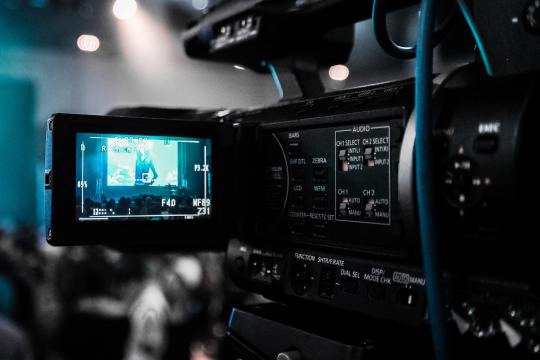
This exercise, which we carried out in one of our film sessions, enabled us to analyse and critique existing fashion films regarding the techniques they used as well as other areas. This allowed us to begin generating ideas for our own fashion film which is to be produced to go alongside our campaign for Fashion Revolution.

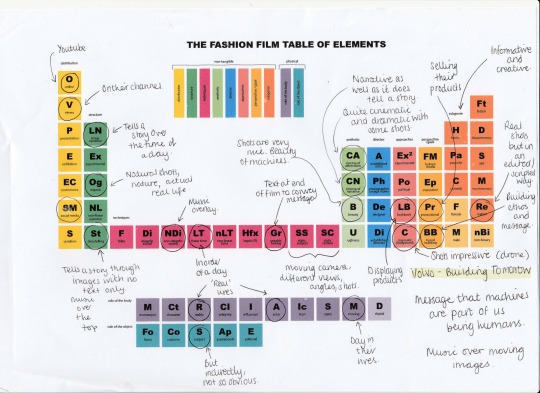
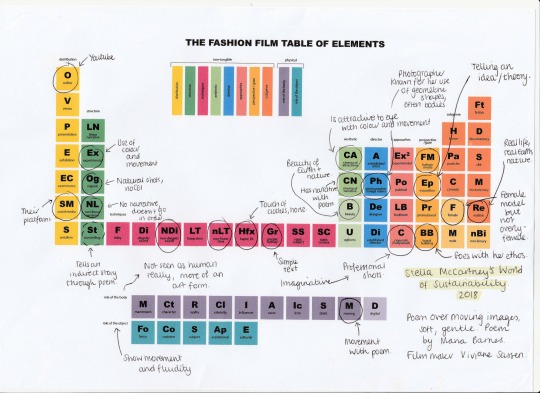
0 notes
Text
AIDA Analysis

Below, shows my AIDA analysis for my proposed campaign for Fashion Revolution- ‘The Fashion Revolution Tour’. This analysis shows how tactics can be used to produce a successful campaign.
ATTENTION:
Attention of the audience will be captured in two ways for the tour. Firstly, attention of academics and teaching staff will be captured through newsletters sent to email addresses of these people. Furthermore, presentations and events will be held in the schools, colleges and universities to engage with academics to persuade them of the advantages of having the tour come to their location. To attract the audience of young people when the tour visits festivals and other events targeted at young people, attention will be raised with social media pages as well posters used at the events as well as on the events’ social platforms. Attention will also be drawn to the campaign when local news coverage is seen. This will raise attention to the tour and encourage more academics and students to become involved.
INTEREST:
To gain interest in the tour, the newsletters and events held to raise interest amongst academics will have to be eye-catching as well as informative and explain exactly what the tour will bring to their students and the valuable experience, they will gain from it. Interest will be gained amongst the younger audience by offering information on the posters as well as making the experience as exciting as possible. Making it attractive to the entire age range means that the poster will be visual and eye-catching with simple information that is not too overwhelming.
DESIRE:
Desire will be created for the campaign through word of mouth as well as reviews which academics and students will be asked to leave on social platforms and the website. With increasing news coverage, desire to take part in the campaign and go on the journey of the tour bus will increase. This will extend the length of the tour- reaching more and more schools, colleges and universities as well as attending events such as festivals. Through the provocation and success of the tour and campaign, the audience will want to cause change and through the handout they are given at the end of the experience, they will be able to leave the experience having a clearer understanding of the issue and also be able to make small changes to their lifestyles.
ACTION:
As the tour gains in popularity and reaches more young people at their schools, colleges and universities, as well as events, the message will be spread wide by an audience who are large consumers of fast fashion themselves. Newsletters will be continued to be sent to continue to cycle to encourage even more people to take part in the tour and experience the journey.
0 notes
Text
Aims of Fashion Revolution Campaign
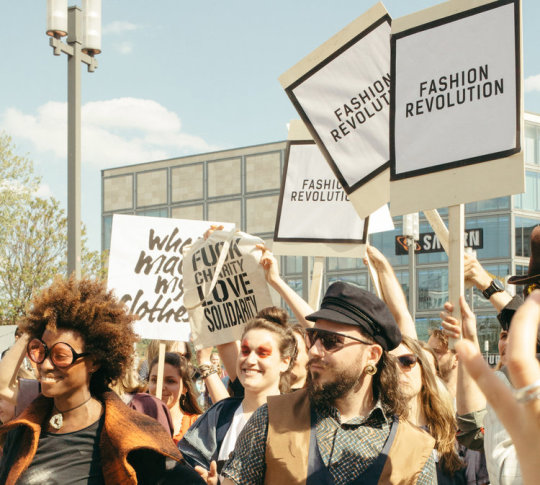
The below aims focus on how the campaign will cause a difference and how the audience will leave the campaign feeling informed and inspired to make a change.
#1 TO QUESTION BUYING HABITS
By completing the 4D experience, the audience will question their own habits and will come out of the experience with a greater understanding and awareness of the issue. They will leave the experience with their handout which will provide them with easy ways in which they can change and make a difference. As people of this age are generally large consumers of fast fashion, this will be targeting the exact correct audience with an experience which they will remember and will be engaged and want to change.

#2 TO CREATE A PROVOCATION
The experience will create a provocation as it will anger those who take part in the experience as to how damaging the fashion industry is to the world. More importantly, it will open the eyes of the audience and inform them of the flaws of the industry and most importantly how they can make a positive change, even a small change.

#3 TO CREATE A LONG-TERM CONNECTION WITH THE ETHOS OF EFFICIENCY, RESILIENCE AND CREATIVITY
The campaign and 4D experience will be memorable and those who experience it will walk away feeling informed and emotional about the cause. They will feel emotions in terms of upset of how the fashion industry is negatively affecting our world as well as feeling passionate for change and how they can contribute. They will therefore leave the experience with a mission to improve their efficiency with fashion as well as their resilience and creativity with their purchases.
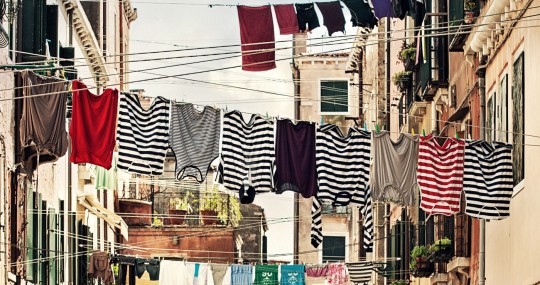
#4 TO ENCOURAGE GRASSROOTS ACTION
With the campaign touring, reaching multiple young adults across the country and potentially the world, the message will reach lots of people and start to change attitudes of fast fashion and create grassroots action amongst ordinary buyers of high street fashion. This message will spread and with handouts being given to every person who attends the tour, showing how they can make small, easy changes to their lives, these changes will soon become apparent with a greater audience reached of those who would not otherwise engage with the cause.

0 notes
Text
Fashion Revolution Proposed Campaign- Initial Idea
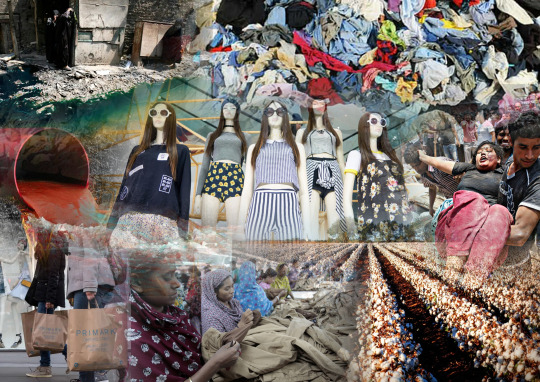
My campaign will involve creating an educational tour in the form of a tour bus or a series of pop-up tents that travel the country visiting schools, colleges and universities attracting an audience of 16-21-year olds.
The tour will involve a 4D experience which the audience will travel through in a series of pods/the tour bus. The journey will take them on a journey and an experience of the backwards life cycle of a garment.
The journey will begin with the audience exploring a retail space. Bright lights, loud music and pristine conditions with mannequins will fill their senses. They will then move on to the transportation side where they will experience the smoke, dust and pollutants of transport with smells of petrol and diesel and loud road noises. Participants will then move on to the factory pollution stage. This will involve strong smells and the sound of water gushing with videos and images as well as facts and information being projected on the walls. Next, they will move into the garment workers stage where they will hear loud shouting, swearing and abuse as well as experiencing the hot and crowded conditions. Then they will move on to an area which represented the amount of land and resources that are needed to grow the materials needed for garment production. Finally, the audience will leave the tour bus/ pods and be immersed in a mini market showing them where they can buy sustainable fashion in their local area.
Also, more information will be provided to them at this point including a small fold out leaflet, showing them how they can make small changes to their fashion lifestyle.
The audience will leave the experience feeling inspired by what they have learnt and the experience as a whole will be memorable due to its 4D experience.
#fashion#fashion communication#research#fashion revolution#moodboard#campaign#fastfashion#pollution#pr
2 notes
·
View notes
Text
PR Campaign Initial Mind Map

This mind map shows initial progress in the development of my campaign for Fashion Revolution. The mind map shows the idea as well as the audience it would attract and also the aims the campaign will successful reach as part of the brief.
0 notes
Text
PESO Analysis Fashion Revolution
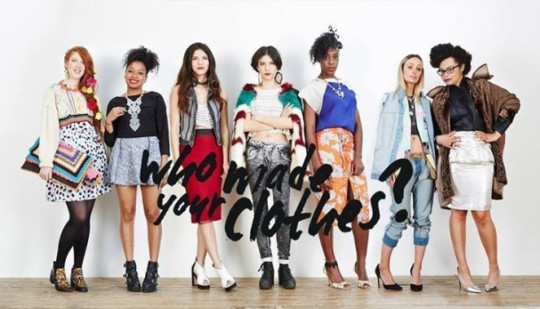
Below is part of a PESO analysis I carried out for Fashion Revolution and how it was currently used media and its content.
Influencer Engagement:
Fashion Revolution has already begun to explore partnering with celebrities and influencers to help their message spread. However, this was only briefly done and only one collaboration has been seen. This was with influencer Arden Rose and the partnership included an interview as well as promotion on social media. However, this is the only collaboration that can be seen on Fashion Revolution’s channels. By exploring more into collaborating with influencers and celebrities this would reach the younger audience, in particular Generation Z- the targeted audience for the new campaign. As well as partnering with influencers and celebrities, Fashion Revolution could also explore partnering with charities and organisations. This would involve the community and also local schools, colleges and universities could join also.

Social Media Usage:
Currently, the social media platforms Fashion Revolution produces are average and the strongest platform is Instagram. The feed is very visual and eye catching, however, the posts are very similar and often are quite text heavy with long captions. This can put a follower off and often they scroll past. On their other platforms such as Facebook and Twitter, the main theme seems to be reposting news stories which relate to the campaign. This is good and interesting to some followers. However, one idea they could explore would be to post what the team is up to on a daily basis. This would give some faces to the campaign and would make the follower want to be more involved with the campaign.

0 notes
Text
Fashion Revolution & Generation Z Analysis
A campaign to attract a new demographic is sometimes challenging and understanding the target audience is important to knowing what will work and what won’t, as generations differ greatly.
In a nutshell, Gen Z are born in the 1990s or later and are highly connected and active in the digital world. They have a sense of financial responsibility and by 2020 they will make up 40% of the world’s consumers. Furthermore, they are keen to make a difference with 60% saying they want to change the world compared with 39% of millennials.
Below is a basic SWOT analysis of how creating a campaign targeted at Gen Z would be beneficial for Fashion Revolution.
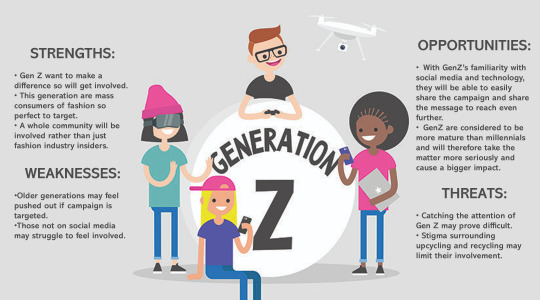
0 notes
Text
Fashion Sustainability VoxPop Quotes
These images show some quotes which I gathered whilst filming my VoxPop on sustainability in fashion. These quotes highlight how little is known about the issue still and how more is needed to reach a wider audience.

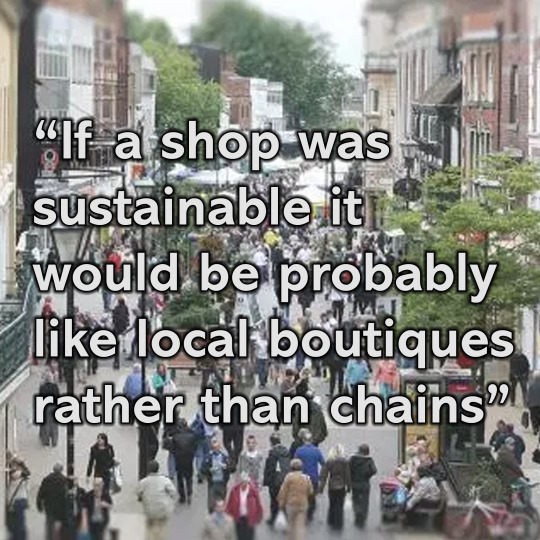

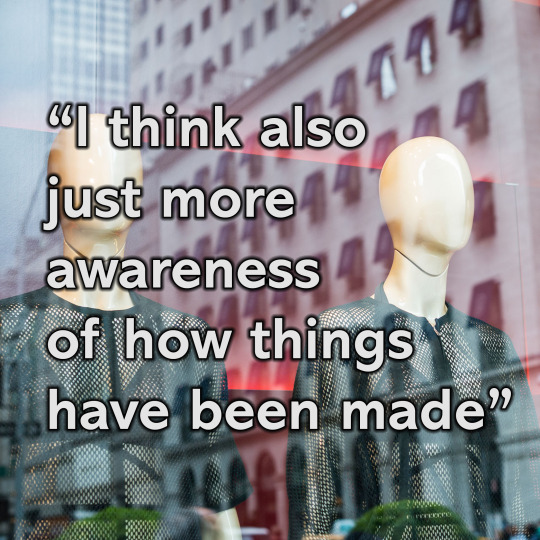
0 notes
Text
5 Thought-provoking PR Campaigns

A successful PR campaign must affect the audience in some way, whether it makes them want to purchase the project or if it causes the audience to stop and think and take something away from the experience. These 5 campaigns have all been successful in this- causing the audience to be shocked and take something away from the experience.
1. Plastic Oceans UK – ‘Future Fish and Chips’
With predictions such as that by 2050 there will be more plastic in our oceans than fish, a drastic campaign was needed to make the harsh reality noticed. Plastic Oceans used secret cameras to capture the reaction of visitors to a fish and chip shop who thought they had ordered their regular fish and chips. What they were served instead caused an uproar. Customers were served battered plastic including plastic bottles and wrappers, all appearing like ordinary fish and chips. Only when the customers started to tuck into their meals did they realise what they had really been served. This caused distress and the customers were very angry with the owner of the shop and demanded their money back. It was only when the owner explained the reasoning and the statistics behind the campaign did the customers stop and think. This campaign was very thought-provoking and had a huge impact on those customers who ordered their fish and chips.
vimeo
2. Andrex + WaterAid – ‘Toilets Change Lives’ Initiative
The campaign involves a pop up scene illustrating how 1 in 3 people in the world do not have access to a safe and clean toilet facility. The pop up, which was organised in London, is shockingly real and invites passers by to explore the space and see the reality for many people living in this way. The space demonstrates what life is like for these people as well as provide real-life accounts of people who only have this option. There is another space also which shows how the two organisations are working together to produce a toilet area which is acceptable and ‘a basic human right’. The campaign is really effective and gives people an experience which they will remember and learn from.
youtube
3. World Vision UK- ‘Lost Teddy Bears’
The campaign was based upon research that was conducted by the organisation, which found that almost half of UK parents have purchased duplicates of their child’s favourite toy in case the original is lost or damaged. The message the campaign promotes is that a lost toy can be replaced but a lost childhood cannot. The campaign encourages passers by to pick up a teddy bear which has instructions attached to it how they can adopt a child to save them from becoming enslaved, a child labourer, a child soldier or a child bride. The campaign used the hashtag #ShareHope (the bears’ name) and the toys were distributed all across the UK in shopping centres, parks and other public spaces.
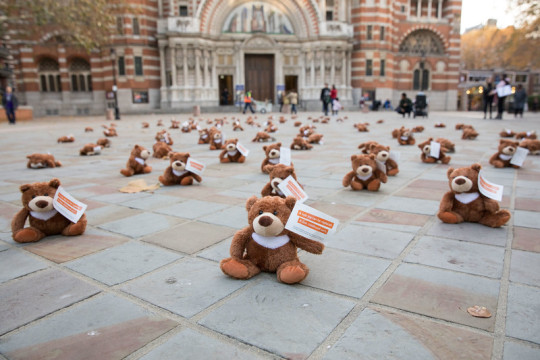
4. Armistice Day 2018 – ‘Sand Portraits’
To commemorate the 100-year anniversary of the first world war, sand artists created portraits of war causalities on numerous beaches across the UK which were then washed away once the tide came in as part of a remembrance survey to remember all those lost during the war. The public were asked to join in with the project by volunteering to help with the artwork or by visiting as part of the service once the portrait had been completed. The project was moving and touching, yet was a simple idea but was highly effective and emotional.
youtube
5. Marie Keating Foundation – ‘Breast Cancer Awareness’
One of Ireland’s most famous, recognisable and Instagrm-ed statue was made part of a campaign to raise awareness about self-checking and breast cancer. The Marie Keating Foundation added a small, temporary lump to the side of one of the breasts on the statue of Molly Malone to raise awareness of the importance of self-checking. Shockingly, no one noticed the change. This illustrated the message for the campaign – ‘be breast aware’- encouraging women to check themselves to ensure early detection.
youtube
0 notes
Text
Audience Research- Creating Personas

As part of my research looking into the audience of our prospective PR campaigns, to involve a new audience in Fashion Revolution’s cause, I created two personas to explore these audiences and also present them in a creative way.
Persona 1 looks at the current audience of Fashion Revolutions and who they are current targeting in their content and message.

Persona 2 shows the future audience of Fashion Revolution who will be captured as a result of a new PR campaign aimed at attracting a younger audience.
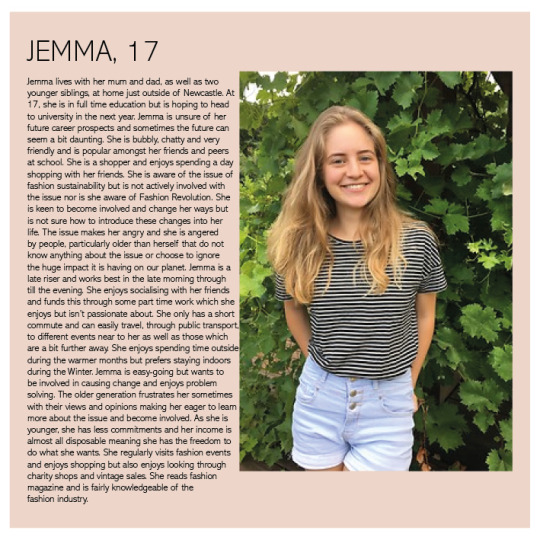
0 notes
Text
Alec Maxwell Social Media Teaser Interview
vimeo
This video shows a snapshot of the interview that was conducted by Chris Hodge with Alec Maxwell from Kloss Films.
As part of our film workshops, we were asked to edit together some clips from the interview to create a social media teaser video which would entice and entertain the audience.
I used Adobe software to create this short film, and by doing so, I have developed my editing and software skills ready for when I make my own short film for our live brief campaign with Fashion Revolution.
0 notes
Text
Sustainability Online Trend Analysis
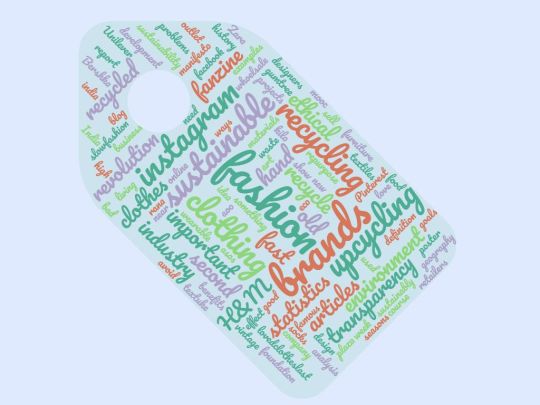
A quick Google search for the term ‘sustainable’ and you will see that 6 out of the 10 suggestions Google makes are to do with fashion. Sustainability and fashion are talking points across the world with New Zealand searching most for the phrase in the last 12 months, according to Google Trends.
The phrase is something that is talked about on an international scale and is increasing in search frequency overall.
The word doodle above shows similar searches and themes that are commonly searched for relating to sustainability and ethics in the fashion industry.
One of the key themes and one of the most common searches is ‘brands’. This shows that consumers are searching for where they can purchase sustainable and ethical fashion and what brands they can support. This also relates to brands which have been named as being unethical and therefore consumers are beginning to avoid. This theme is evident with consumers engaging with Fashion Revolution’s campaign #WhoMadeMyClothes. Consumers are beginning to questions brands and ask for transparency.
Another common theme was ‘recycling’ and ‘upcycling’. This shows that more searches are being made for these processes which help the environment and shows signs that we are beginning to move away from our huge consumption of fashion and looking to reinvent our clothes rather than contribute to an ever-growing pile of textile waste.
One result that stood out when a Google search was made for Fashion Revolution was ‘instagram’. As one of Fashion Revolution’s platforms, Instagram seemed to have the highest frequency in searches online. This demonstrates that people are continuing to find the platform and also shows that this is the organisation’s most popular platform. This means that consistent posting on Fashion Revolution’s Instagram page is vital to keep engaging with the population who are eager to be involved.
The image above was created using Word Clouds and I used Google Trends and Keywords Everywhere to search for common themes and trends.
#fashion#fashioncommunication#research#fashionrevolution#whomademyclothes#ethics#sustainable#future#words#trends#themes#worddoodle#imagery#graphic#fastfashion#consumption#recycle#upcycle#google#brands#transparency#instagram
0 notes
Text
The Future of Fashion Sustainability

What is sustainable fashion to you? And where is it going?
Sustainability in the fashion industry is becoming a widely talked about area with more and more brands waking up to the idea of creating their products in an ethical, sustainable and most importantly a transparent way, so we, as consumers, can see for the first time where our clothes we wear actually come from and how they were made.
The problem of fast fashion and our huge consumption of clothing is still a problem and is nowhere near being solved just yet.
Change is happening though across the world and with the voices of consumers finally being heard, big brands are starting to change their ways. There is still lots to do and for organisations like Fashion Revolution, their constant work is becoming a great success, but consistency is key as we continue to spread the message.
With Brexit on the horizon, the future is uncertain for most. The fashion industry is one area facing struggles due to changing trade deals, most likely causing price increases. However, this increase is not fully understood as will the increase be big enough to make a change or will our shopping habits carry on as they are?
Lower labour costs abroad cause big brands to gravitate to these countries where workers are often given an unfair wage as well as exploited and even abused in some cases. Events such as the Rana Plaza collapse in 2013 shocked the world and brought the issue of these workers to global attention. As Lucy Siegle said "Fast fashion isn't free. Someone, somewhere is paying". Consumer spending habits are changing as well as competition growing in the fashion industry which means lower prices for consumers. With this increased competition and volume of fashion, consumers face pressure to better themselves in today’s society with so many options available to them. Will they ever stop buying them or is our industry built on security?
Stigmas surround second hand clothing and the nature of upcycling. People demand new and don’t think twice about chucking out the old. Social media has aided this cultural stigma in China further. The total amount of clothing and textile waste in the UK is approx. increasing 2.35 tonnes a year. With the current use of influencers on social media used to promote purchases for brands, will influencers be used for good in the future and used to promote messages and use their platform to call for action in a damaged society.
With technology growing everyday, the need for fast fashion is met by quicker and advanced technologies supplying this desire. Social media hashtags and challenges are a method used to create huge impact on a quick scale. Messages can be spread internationally within a matter of seconds.
The systems used to represent and keep workers safe are outdated and this is dangerous not only for their jobs but also their lives. Union representation is needed to validate workers’ voices and encourage enforcement. They need to have their opinions heard more clearly by employers. Only 5-10% of workers in developing countries have access to occupational health services. The UK and USA have put laws in place to gain more transparency, but more is needed.
Some brands are more environmentally friendly than others and they have taken sustainability seriously. H&M being one example, aim to be 100% by 2030. Currently, 59% of their cotton is sustainably sourced. Transparency and authenticity ensure success. Stella McCartney is another example of a brand who’s transparency and respect to the environment is part of its success. Issues such as animal welfare, ethically sourced fabrics make the brand an advocate and a pioneer for this direction for the fashion industry to take. The environment will suffer due to overpopulation with the population growing to 10 billion people by 2050. As this number rises, resources must be used sustainably in order to maintain wellbeing of the population.
How sustainable do you feel you are with fashion?
Where do you feel the issue is going?
#fashion#fashioncommunication#research#fashionrevolution#whomademyclothes#ethics#sustainable#future#moodboard#imagery#fastfashion#consumption#change#influencer#transparency
0 notes
Text
Fashion Film Workshop #1

Our first research session focused on looking at the area of fashion film and its current themes. By conducting this research, I was able to view previous examples of films created to convey a message to the audience and use this to inspire my own ideas.
Below are some of the areas we were asked to investigate further and find examples of to inspire our own thoughts and creations.
POLITICAL MESSAGES IN FILM
“1914″ - Sainsbury’s Christmas Advert, 2014.

This short film was released by the British supermarket Sainsbury’s in 2014 as their Christmas marketing advert. The film shows how British and German soldiers come together at Christmas. The moving film shows the two armies singing carols together and joining in a game of football, before they are reminded of the circumstances. Despite receiving comments such as “Best Christmas advert ever” by fans, the advert also received criticism for romanticising the war despite the millions of death seen in World War 1. Some claimed it portrayed a damaging political message, that could have been perceived to be taken too far.
“Say hello to Rang-tan” - Iceland’s Banned TV Christmas Advert, 2018.
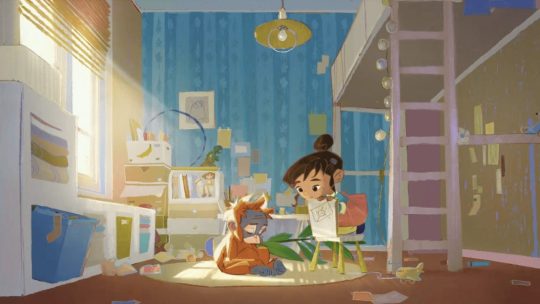
Iceland’s most recent Christmas advert tells the story of an orangutan who’s home is being destroyed due to palm oil production. This touching advert has been viewed nearly 6 million times on Youtube after the brand revealed that the short film had been banned from airing due to political messaging in the advert. There was public out-roar at this advert being banned, but it was stated that the advert held political messages, similar to those of the Green Party, and was therefore not allowed to be aired on television.
INNOVATIVE WAYS OF CREATING A CALL TO ACTION
After researching and watching existing and past campaigns, I noted that there were certain features that made these films successful in their aim- to cause a change. These included carrying out a social experiment which can catch people’s attention. For example, I watched the “The 2 Euro T-Shirt - A Social Experiment” film which was produced by Fashion Revolution in 2015. The short film has already had over 7 million views and it received global coverage.
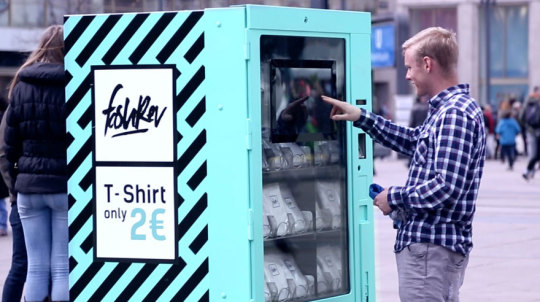
Other ways include asking a question to the audience to really engage them and questions their own views and actions. I also watched the short film produced also by Fashion Revolution- “ For the next 2 minutes this will be the mobile phone of a garment worker in Bangladesh”. This film was really engaging and my reaction, as well as others I showed it to, was a sense of shock. This is good to engage your audience and it made me think about the video long after actually watching it myself.
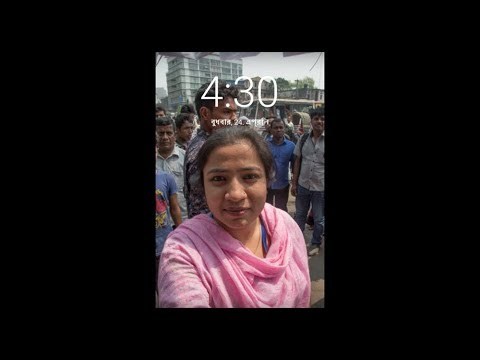
Other innovative ways of creating a ‘call-to-action film’ include using no sound and no speaking for the entire film. This encourages the audience to pay close attention to the video and is also a effective way of displaying facts that the audience may find shocking or surprising. Finally, I researched examples of how street art was used to display colour and visual stimulation in a short film which I found very effective.
My initial research into finding out what makes a successful fashion campaign film was really useful and I have learnt about lots of techniques which I can certainly take with me and inspire my own creations.
#fashioncommunication#fashionrevolution#campaign#research#fashion#film#fashionfilm#calltoaction#change
1 note
·
View note